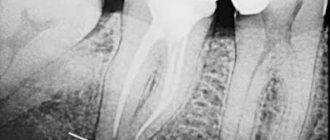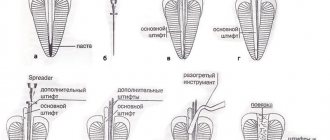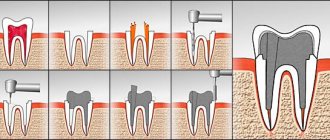So, when caries develops to a deep degree, and the inflammatory process spreads to the pulp (in other words, the nerve), there is a high probability that the doctor will have to fill the canals.
First of all, we note that filling can be temporary - for treatment or permanent. Permanent filling is the final and most important stage of endodontic treatment. This will be discussed later.
The purpose of obturation (sealing, completely closing the lumen in an empty canal) of the root canal is to eliminate the paths of leakage of various substances from the oral cavity into the root canal system and to seal internal irritants that cannot be completely removed during the cleaning and shaping process.
There are many filling methods; we will briefly describe the main ones.
Indications
The cavity located inside the tooth, where the nerve endings and blood vessels are located, is called the pulp. If the caries lesion is not treated in a timely manner, the pathology reaches the pulp, which leads to the occurrence of an inflammatory process called pulpitis. The process does not go away on its own; the pain that inevitably arises is removed by painkillers in the initial stages. Over time, they also stop working. In advanced cases, inflammation spreads to the bone, which leads to periodontitis and, as a consequence, osteomyelitis. The main indication for root canal filling is pulpitis caused by caries.
Glass ionomer cements
This variety is distinguished by its composition, which simultaneously includes liquid and powder components. A prerequisite is coating with a protective varnish; this material is usually used in pediatric dental practice.
The features of some types are discussed below:
Ketac-Endo
Provides good adhesion of surfaces and slight shrinkage of the filling. The installed filling releases fluoride, which is a good prevention of caries.
Among the disadvantages are the porous structure, low level of strength and destruction of the tooth surface.
Endion
It is a glass ionomer cement, which differs positively from most analogues in its excellent compatibility with all soft tissues, and it additionally provides them with high protection from bacterial attack.
Toxic components are completely excluded from the composition, which ensures a high degree of safety, but the cement has an opaque structure, is very fragile and is not suitable for filling chewing teeth.
Filling methods
Until recently, the procedure was carried out using pastes, which are inexpensive and do not require complex technologies. Now professional dentists have abandoned them due to insufficient fluidity, which leads to the formation of cavities. Voids lead to depressurization and relapse of inflammation.
At the moment, doctors choose progressive methods:
- Thermophile system. The filling is performed with hot gutta-percha, which hardens as it cools. It is characterized by high plasticity. There is no pain after treatment. The risk of complications is minimal;
- depophoresis. It is used for filling difficult, curved canals, as well as for restoring elements from which it is difficult to remove old fillings and where fragments of ostomy instruments remain in the cavities. Efficiency - no less than 95%;
- E&Q Plus. The latest generation method, which provides various methods of filling the roots of one tooth. The injection gun heats the gutta-percha directly inside the cavity. The doctor can control the temperature of the material using the information display.
Another common method is filling the canals with cold gutta-percha, which is used in several ways:
- lateral condensation;
- softening due to chemical action;
- with one pin. To give the shape, a pin is installed in the canal. Sealing is ensured through the use of paste.
There are other technologies that are selected depending on the location of the channels, the condition of the tissues and the experience of the doctor.
Clinical researches
As a result of clinical experiments using the Asepta series of products, conducted at the Kazan State Medical Academy, the complex use of anti-inflammatory drugs from the Asepta line contributed to faster relief of inflammation, the combined use of balm, gel, rinse, toothpaste and vitamin-mineral complex mutually enhanced the therapeutic effect did not require daily visits to the dentist.
Sources:
- The use of drugs from the Asepta line in the complex treatment of inflammatory periodontal diseases (N.V. Berezina E.N. Silantyeva S.M. Krivonos, Kazan State Medical Academy. Kazan.) N.V. BEREZINA, E.N. SILANTIEVA, S.M. KRIVONOS Kazan State Medical Academy
- The role of anti-inflammatory rinse in the treatment of periodontal diseases (L.Yu. Orekhova, A.A. Leontyev, S.B. Ulitovsky) L.Yu. OREKHOVA, Doctor of Medical Sciences, Prof., Head of Department; A.A. LEONTIEV, dentist; S.B. ULITOVSKY, Doctor of Medical Sciences, Prof. Department of Therapeutic Dentistry of St. Petersburg State Medical University named after. acad. I. P. Pavlova
- Report on determining/confirming the preventive properties of commercially produced personal oral hygiene products: Asepta toothpaste used in combination with Asepta mouthwash and Asepta gum balm Head. Department of PFS Doctor of Medical Sciences Professor S.B. Ulitovsky St. Petersburg State Medical University named after Academician I.P. Pavlova. Faculty of Dentistry. Department of Preventive Dentistry.
Stages of canal filling
First of all, the doctor carries out an examination and the necessary diagnostic operations, which may include, for example, an X-ray examination of the oral cavity.
If suspicions about the need to fill the canal are confirmed, the dentist carries out preparatory manipulations. First of all, adequate anesthesia. After it has taken effect, the caries-affected tissue is removed using a burr. The dental nerve is then removed. Next, the doctor is engaged in mechanical processing of the endodont - a complex of dental tissues, including pulp and dentin.
Upon completion of the preparatory stage, the empty root canal is filled, then a permanent filling or crown is installed.
How we are working?
Endodontic treatment in our dentistry can be carried out in one visit. However, sometimes it is carried out in two stages with the installation of a temporary filling.
- Initially, the doctor carefully studies the previously taken x-rays, determines the structure of the organs, the focus and area of the lesion, perforation and plans the therapeutic process. Then he performs local anesthesia and, using a rubber dam (latex plate), performs manipulations - he isolates the tooth to prevent saliva and infection from entering its cavity and to avoid over-treatment.
- The enamel and dentin are drilled out, the dentist removes the affected tissue, cleans the internal space of the roots using special miniature instruments, and hermetically fills it with an obturating mass.
- Restoration of the appearance of the tooth is carried out using ceramic filling material or an anatomical crown of the desired shape and size placed on top.
Description of the procedure
- Local snapshot. X-ray allows you to see the condition of all channels, their number, location. In difficult cases, a 3D image is taken.
- Anesthesia.
- Drilling of diseased tooth tissues.
- Removal of nerve and blood vessels.
- Determining the depth of the canal using an apexolator.
- Widening the passage to place the drug and install the pin (if required).
- Filling.
- Control photo.
After treatment, it is not recommended to consume hot drinks and food for 1 – 2 hours.
Calcium hydroxide cements
This material is a set of tubes with several pastes, which are mixed with each other before use.
Below are the features of some types:
Apexit
It has a positive effect in cases of poor-quality cavity cleaning, as it promotes hardening of pulp residues. There is no sedimentation of the filling at all; during repeated treatment, the cement can be easily removed from the canal. The material demonstrates excellent sealing and a high level of compatibility with all soft tissues.
The only disadvantages include fragility and the mandatory application of an insulating layer under the filling.
Sealapex
It has an antibacterial effect, the material is suitable for filling any teeth, since it does not change the color of the enamel. High fluidity and other properties ensure ease of treatment.
Disadvantages include fragility under mechanical stress and the need for spot installation.
Temporary filling
In some cases, medicine is introduced into the canals for a certain period of time. Manipulation is carried out for:
- elimination of pathological microflora;
- stopping the inflammatory process;
- isolation of the canal, when it is impossible to carry out treatment in one visit.
Indications for temporary installation of a filling are injuries, perforation of walls, periodontitis in acute or chronic form.
The main active components of medicinal non-hardening pastes are antibiotics.
Cost of services
Consultation with an implant surgeon 0 rub.
1-canal tooth (canal filling with gutta-percha pins) 750 rub.
2-canal tooth (canal filling with gutta-percha pins) 980 rub.
3-canal tooth (canal filling with gutta-percha pins) RUB 1,300.
Placing a temporary filling costs 200 rubles.
Compomer filling for permanent teeth RUB 1,000.
Filling for permanent teeth made of gypsum resin, cotton RUB 1,200.
Filling for permanent teeth made of photocomposite RUB 1,800.
Placement of a light-curing filling for non-carious lesions RUB 2,000.
Placement of a light-curing filling for average caries RUB 2,500.
Placement of a light-curing filling for deep caries RUB 3,000.
Placement of a light polymerization filling for periodontitis (taking into account the formation of a cavity and the application of a lining) RUB 2,350.
Placement of a light polymerization filling for pulpitis (taking into account the formation of a cavity and the application of a gasket) RUB 2,370.
Restoration of the crown part of a tooth using light polymerization materials (caries) RUB 3,050.
Restoration (caries, pulpitis) RUB 4,650.
We recommend that you read
Treatment of wisdom teeth
Dental treatment during pregnancy
Treatment of anterior teeth
Dental filling
Possible complications after canal filling
In the absence of complications, the process can take about one to one and a half hours. But in severe and advanced cases, it may require several visits to the dentist.
The most common type of complications after filling a tooth canal is the neglect of the inflammatory process, accompanied by focal tissue destruction. In this situation, a temporary filling is installed from a non-hardening paste containing medications. The time of wearing it and the composition of medications is determined by the doctor during an individual consultation. This treatment shows high effectiveness for diagnoses of cystogranuloma and periodontitis.
Materials for canal filling
Unfortunately, situations are common in which pain continues to torment the patient even after all medical procedures have been completed, and after the period adequate for rehabilitation has expired. The reason for this reaction of the body may be an error in choosing the filling material. There is still no universal substance that would suit everyone. Consequently, dentists, based on their knowledge and the results of examining patients, each time make a choice in favor of one material or another.
Today the following substances are used for canal filling:
- fillers. They are represented by gutta-percha, silver and titanium pins;
- sealers. These are different types of cements, including polymer, natural, glass ionomer or containing calcium hydroxide, as well as polydimethylsiloxanes.
Gutta-percha can be called perhaps the most popular material due to the complex of its properties:
- leaves the tooth color unchanged;
- copes with absolute sealing;
- not subject to dissolution;
- not subject to deformation.
Types of endodontic filling materials
They can be divided into two groups. The first is solid fillers (fillers):
- Gutta-percha. It is a standard material used in endodontics. It is a natural polymer obtained from the sap of the gutta-percha tree. Root canals are filled with gutta-percha very often, since it is a non-allergenic, biocompatible material with high efficiency.
- Pins. They can be silver, titanium, plastic, fiberglass and combinations.
The second group includes liquid fillers - sealers. They are represented by various hardening and non-hardening occlusive masses. Typically they are used with gutta-percha and their main purpose is to fill remaining voids.
Tooth canal treatment methods
Along with canal filling, other techniques are common in modern dentistry that allow you to preserve both the appearance and functional load of teeth.
These include:
- depophoresis method - designed to increase the efficiency of cleaning the canal from pulp tissue. It is based on the effect of copper-calcium hydroxide and a weak electric field on tissue.
- The method of obturation with the Thermofil system allows you to introduce thermoplasticized gutta-percha into the prepared root canal with high precision.
- Treatment with cold or heated gutta-percha allows you to achieve perfectly accurate filling of all tooth cavities after treatment.
It is important that the dentist strictly follows all ISO standards when selecting the instruments required for endodontic treatment. The caliber, diameter and even color of the instrument play an important role.
Medical errors in endodontic treatment
According to some data, Russian specialists achieve success with endodontic treatment in only 30% of cases.
The most common mistakes include:
- incomplete obturation (when filling the prepared dental cavity with filling material, air bubbles remain; the material does not adhere tightly to the tooth tissue);
- insufficiency, low quality of antiseptic treatment (threatens the occurrence of an inflammatory process);
- deformation, breakage of the pin or tool.
Can an ordinary patient who does not have a medical education determine the degree of qualification of the endodontist he sees? Yes. The first, main sign of a low qualification of a doctor or insufficient technical equipment of the clinic is the lack of an X-ray examination at the beginning of therapy.
If inflammation occurs or if pain lasts for an inadequate duration after filling a tooth canal, you should immediately consult a doctor. Delay may result in tooth loss.
Expert of the article you are reading:
Lozinskaya Alla Nikolaevna
Pediatric dentist, general dentist.
You may also be interested in:
Treatment of dental canals Treatment of teeth during pregnancy Dental consultation Treatment of dental cysts Increased sensitivity of teeth: causes and methods of treatment Treatment of pulpitis Treatment of fistula on the gums Treatment of flux (periostitis)
Show more
Natural cements
Cements for sealing dental canals are called sealers.
There are a number of natural materials of this type, the main options are discussed below:
Endomethasone N Poudre cement
It is very easily inserted into the dental canal and is subject to slow resorption. It contains additional additives with an antiseptic effect, which is a good prevention of possible inflammation.
Other positive properties include excellent X-ray contrast, which makes it easier to monitor the situation from images. Among the disadvantages are the toxicity of some components, a high risk of pain and the development of an allergic reaction.
Cortisomol
In powder form, it has all the advantages of the previous version; it also contains steroid hormones that relieve pain during rehabilitation after surgery.
The main disadvantage is that it dissolves quite quickly in tissue fluids; moreover, this material stains the enamel, so it cannot be used for the restoration of anterior teeth.
Tubliseal
Fills all microscopic cracks in the shortest possible time, providing perfect sealing, and is also characterized by rapid hardening, which occurs under the influence of heat and moisture.
Disadvantages include rapid leaching from the canals and the presence of corticosteroids in the composition, which impair the protective qualities of some tissues.
Canason
It has excellent properties: it is not washed out or dissolved by tissue liquids, it seals channels well, has an antiseptic effect, relieves inflammation, provides protection against bacteria, and is perfectly displayed in photographs.
The only drawback is the complexity and duration of the procedure.










